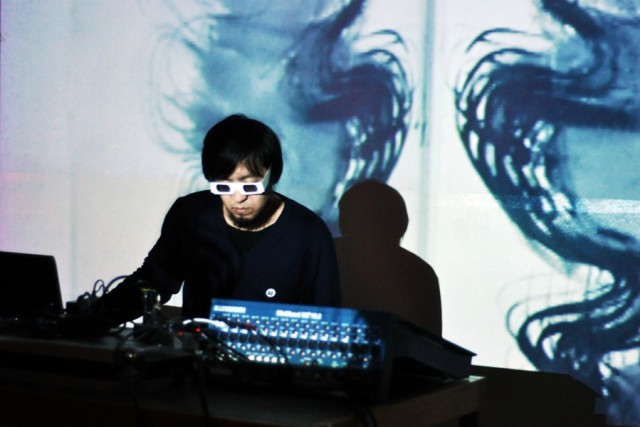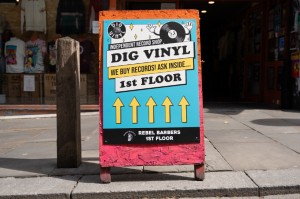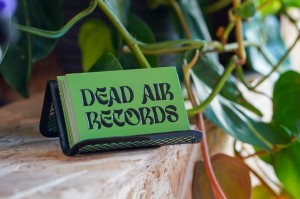NHK’Koyxen with Drawing Paper
Julian Shepherd gets to grips with the latest happening programmed by Deep Hedonia and Drawing Sessions…
Following the enormous success of Drawing Sessions 2 last year, there was a very different air to tonight’s collaborative show with Deep Hedonia, marked by a shift in focus from group activity to an assault on the senses. Directed from live visual intervention at the rear of the Blade Factory with an arrangement of three highly complex technical A/V set-ups from Drawing Paper co-founder Jon Barraclough, it consisted of fixed-rostrum cameras, tripods, jaunted angles, control levers and spaghetti cabling fashioned into black knotted shapes.
One of the most interesting of these I had explained to me three times, by members of Deep Hedonia and The Royal Standard, and after staring at it for a good 10 minutes trying to contemplate and understand how it all worked, still did not manage to flick a single iota from my clearly shrunken frontal lobe. I’m glad the venue hadn’t opened and they were still setting up for the night. It saved me the social humiliation.
Even in its most basic form, as a sketch on the back of a napkin, I’d have found this set-up concept fascinating. A right-angled handmade wooden structure cantilevered across a rotational turntable platter, with panels of mirror suspended from it to refract light sources (flexible angle-poise lamp and hand-held LED light poles) which were twisted and shaken to excellent effect. At a sharp angle, a large DV camera, from which it went through a newly acquired mid-1980’s vision-mixer, disrupted with unknown button functions and beamed out across the far wall. This mixture of potential visual outcomes devised in this raw, barebones manner, created startling, entirely unrelated and highly complimentary viewer experiences, whilst each performer played out their sets.
The performance space and staging was a stripped back visceral introduction, settling myself down on the Blade Factory’s new FVMA-tiered seating system, back-bar behind me illuminated with a rich tomato neon glow burning out from the shadowy recesses. With the doors latched open, the space quickly began to fill up and conversation and laughter rippled delicately around exposed columns and scratched grey concrete. With jazz-tinged plodding keys and a trumpet solo playing away, there was enough to raise the charge of the room exponentially, whilst remaining toasty enough to feel at ease. I was ready to dance, but being lost in the moment was also confused and wanting to heap myself in a thick blanket. It was a peculiar experience.
Opening was Bantam Lions, aka Mike Carney, who released his debut EP on Liverpool’s Scenery Records last December. It wasn’t a set as such, more a series of intertwined verses, filled with works in progress, stripped back ideas, live experimentation, keys, claps, building up layer by layer to an eventual and heady bass drop over ten minutes into the performance. Thoroughly enjoyable and somehow familiar, it was reminiscent of the Mike Grant and Moods N Grooves Detroit-era sound from the beginning of the last decade.
During his performance, layered video projection of a stacked pile of glossy white paper was illustrated with random-thought processed patterns and lines using an array of black marker pens and blue felt tip. Airing a watercolour depth, it felt a little like the makings of ancient Japanese iconography. In addition, the strangest splayed brush I’ve ever seen, like a full set of eyelashes, was dipped into ink and scraped in wave forms across the glossed surface, marking with an impression as though it had been directly combed into the paper. The converted record player I previously mentioned, that too had twelve-inch paper cut-outs spinning away with all manner of considered daubs and scuffs in motion waving.
After a lot of unplugging and reassembly, next up was Isocore of Up It Up Records, bringing a lot more of an abstract take to proceedings, starting off and graduating into 8-bit samples and scattering of heavy basslines, one of which I’d somehow instantly referenced back to Technotronic’s Pump Up the Jam in a split second. I know that sounds completely crass and will induce yells of extreme trauma from afar, but genuinely, that’s exactly what spoke to me. Apologies in advance, we all have our guilty pleasures.
Behind him, in a perfect contrast to his red striped jumper, two separate illustrations were relayed on top of each other in black, graphite rubs swirling like viscous fluid, protruding tentacles in blue and red line with live invertion to squeaks, pops and clangs.
NHK’Koyxen stepped up for the headline performance and genuinely, the Blade Factory couldn’t have been a more appropriate venue for his sound. Kouhei Matsunaga, a former architecture student and accomplished visual artist in his own right, had his second album for PAN, Dance Classics Vol. II, released in November, with a third chapter currently in production and is in the middle of an extensive European tour, which draws to a grand finale in Eastern China next month.
In the midst of his mangled aural beauty, it was not difficult to identify the many influences stretching from hardcore techno back into hip-hop, and its skittering loop sequences leading me from the internal emotion of a lullaby, playfulness to haunting intangibility, watery depths and disjointed metal tapping. Almost a lo-fi rave, it took me back to the days when I was younger, fitter and would frequent all night parties in abandoned railway tunnels, coming home with rust infused mud caked all up my trouser legs.
Julian Shepherd









